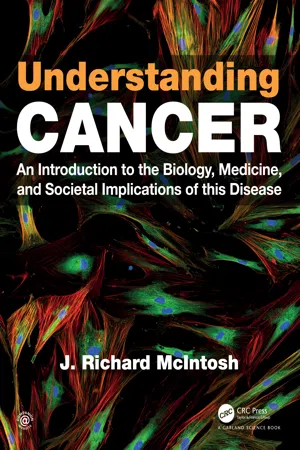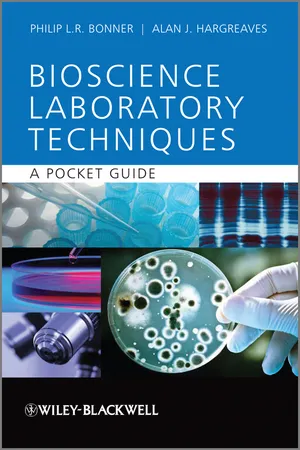Biological Sciences
Methods of Studying Cells
Methods of studying cells include microscopy, cell culture, and molecular techniques. Microscopy allows for the visualization of cell structures and organelles, while cell culture involves growing cells in a controlled environment for experimental purposes. Molecular techniques, such as PCR and DNA sequencing, enable the study of cellular processes at the molecular level.
Written by Perlego with AI-assistance
Related key terms
Related key terms
1 of 4
Related key terms
1 of 3
4 Key excerpts on "Methods of Studying Cells"
- eBook - ePub
Understanding Cancer
An Introduction to the Biology, Medicine, and Societal Implications of this Disease
- J. Richard McIntosh(Author)
- 2019(Publication Date)
- Garland Science(Publisher)
Acquiring this knowledge has taken a great deal of time and work, largely because cells are so small and complicated (FIGURE 3.1). As mentioned in Chapter 1, most of the cells in our bodies are so tiny that a lump containing a million cells is not much bigger than a pinhead. Thus, visualizing a single cell requires a microscope. A good light microscope will let you see the overall shapes of cells, focus in on the multiple structures within them, and watch cells as they perform their various tasks (SIDEBAR 3.1). Light microscopes have been developing over several centuries, and they are now essential tools in cell biology and other cancer-related sciences. Chemistry and molecular biology have provided many facts that are essential for understanding cell structure. The science of biochemistry, initiated more than a hundred years ago, has produced methods and knowledge that have allowed scientists to isolate and characterize many of the molecules from which cells are built. One of these molecules is DNA, whose structure was discovered in the early 1950s. Since then, a special field has developed to study the biology of DNA and how it functions in cells. Work in this field, which is called molecular biology, has achieved many insights into how cells process and use the information stored in DNA to control cell growth and reproduction. Although molecular biology is a comparatively new science, its contributions to our understanding of cellular biology have been extremely important. FIGURE 3.1 Diagram of a cell with labels on many of its parts that are visible with a light microscope. When human cells are taken from the body, for example, in a biopsy, and transferred to a sterile vessel that contains a suitable growth medium (water, salts, sugars, amino acids, vitamins, etc.), they will attach to the bottom of the vessel and spread out. They then look much like this diagram. Each cell contains many different structures, as labeled here and discussed further in the chapter - eBook - ePub
- Britannica Educational Publishing, Kara Rogers(Authors)
- 2010(Publication Date)
- Britannica Educational Publishing(Publisher)
CHAPTER 6The Study of CellsT he study of cells as fundamental units of living things forms the basis of the field known as cell biology. The earliest phase of cell study began with English scientist Robert Hooke’s microscopic investigations of cork and his introduction of the term cell in 1665. In the 19th century two Germans, the botanist Matthias Schleiden and the biologist Theodor Schwann, were among the first to clearly state that cells are the fundamental particles of both plants and animals. This pronouncement—the cell theory—was amply confirmed and elaborated by a series of discoveries and interpretations.In 1892 the German embryologist and anatomist Oscar Hertwig suggested that organism processes are reflections of cellular processes. His work established cytology (now generally referred to as cell biology) as a separate branch of biology. Research into the activities of chromosomes led to the founding of cytogenetics, in 1902–04, when the American geneticist Walter Sutton and the German zoologist Theodor Boveri demonstrated the connection between cell division and heredity.Modern cell biologists have adapted many methods of physics and chemistry to investigate cellular events. Improvements in techniques for growing cells in the laboratory have revolutionized science and medicine. For example, scientists now can build “bioartificial” tissues for transplantation into patients and are able to investigate individual steps in the process of cell differentiation. These developments have important implications in medicine, specifically for the regeneration of tissue in persons affected by certain diseases.THE HISTORY OF CELL THEORY
Although the microscopists of the 17th century had made detailed descriptions of plant and animal structure and Hooke had coined the term cell - No longer available |Learn more
Basic Bioscience Laboratory Techniques
A Pocket Guide
- Philip L.R. Bonner, Alan J. Hargreaves(Authors)
- 2011(Publication Date)
- Wiley(Publisher)
Ultrastructural detail of all the above macromolecular structures can be seen using transmission electron microscopy. Although structural detail of macro- molecules cannot be visualized directly in the light microscope, it is possible to demonstrate the location and distribution of many macromolecules within cells and tissues with the aid of histochemical staining (see later). In combination with biochemical sub-fractionation techniques, microscopy has played a central role in the study of cell structure and organelle function.Student exercise2.2 Microscopes – General Principles- Draw a labelled diagram of a typical animal cell, indicating the main structural components.
- List any additional structures that are absent from animal cells but present in (a) plant cells and (b) yeasts.
- Indicate which of the structures found in eukaryotic cells are absent from prokaryotes.
All microscopes consist of a coordinated system of lenses providing a magnified image of the specimen. They are invaluable tools in the study of the structure, organization and migration of cultured animal and bacterial cells. Microscopy can also be used to determine tissue organization and the viability, distribution and function of cells within tissues as well as the identification, organization and quantification of organelles and macromolecules within cells and tissues. Microscopy therefore has applications in all of the bioscience related subjects including microbiology, cell biology, biochemistry, biomedical sciences, forensic science, pathology, toxicology, plant biology, and so on and is particularly useful at providing supporting data for molecular studies of cellular components.The type of microscope needed for a particular task depends on the level of detail required. The main differences between the different types of microscopes are the wavelength of electromagnetic radiation (see Chapter 3) used to obtain the image, the nature and arrangement of the lenses and the methods used to view the image. In this chapter we will look at the principles of light and electron microscopy, but first of all we will consider some general principles applicable to all types of microscopy. - S. Bradbury(Author)
- 2014(Publication Date)
- Butterworth-Heinemann(Publisher)
CHAPTER 1SOME TECHNIQUES USED IN THE STUDY OF CELLS AND TISSUES
Publisher Summary
This chapter discusses a few techniques used in the study of cells and tissues, including phase contrast and interference microscopy and electron microscopy. The great advantage of phase contrast microscopy is that it introduces contrast by optical means into unstained preparations of transparent objects. In the electron microscopy method, the energy source is a beam of electrons emitted from an electrically heated tungsten cathode situated at the top end of a tube in which a vacuum is constantly maintained by means of a series of pumps. The great advantage of the electron microscope lies in its far greater resolving power as compared with the optical microscope. The resolving power of the latter, that is, its ability to image two small objects close together so that they appear separate and not as one, is a function both of the numerical aperture of the objective and of the wavelength of light. Because of the very poor penetrating power of electrons, very thin slices of tissue have to be used in electron microscopy.Many new methods for the study of histology have been developed during the last fifteen or twenty years. Some of these have such a wide application and are producing such important and interesting results that it is necessary for the student to be acquainted at least with the principles underlying them. The following is a brief account of the more important among them.A Methods of Looking at Cells
(1) Phase Contrast and Interference Microscopy.
The need to study living cells is becoming increasingly important and the conventional optical microscope has severe limitations in this respect, as indeed, has the human eye. Most living cells are virtually transparent objects whose constituent parts differ but little from one another in refractive index, so that there is hardly any visible contrast between them. Moreover, the refractive index of most living cells is very close to that of the aqueous media in which they are likely to be placed for microscopical examination. In consequence living cytoplasm appears structureless and empty to a large degree. This is, of course, one of the reasons why, in the past, so much use was made of cells that had been chemically treated (fixed) and coloured with various dyes, because this method revealed structures that could not be seen in the living cell. It was often open to question, however, whether such structures were artifacts of the technique rather than objects actually present. The great advantage of phase contrast microscopy is that it introduces contrast by optical means into unstained preparations of transparent objects e.g. living cells. A mathematical treatment of the theory of phase contrast is complex, but the following general account will serve to introduce the principle of the method.
Index pages curate the most relevant extracts from our library of academic textbooks. They’ve been created using an in-house natural language model (NLM), each adding context and meaning to key research topics.
Explore more topic indexes
Explore more topic indexes
1 of 6
Explore more topic indexes
1 of 4



